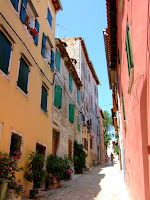 Since we arrived in Poreč too late to see the main attraction, the Basilica of Euphrasius, it was our starting point today. This Byzantine Church, another World Heritage Site,
Since we arrived in Poreč too late to see the main attraction, the Basilica of Euphrasius, it was our starting point today. This Byzantine Church, another World Heritage Site,  built in the 6th century has some of the most incredible gilt mosaics in the Apse. The other feature is the Ciborium in the presbytery; from the 13th century this is also decorated with fabulous mosaics and supported on four marble columns. There is also a collection of Roman mosaics on display.
built in the 6th century has some of the most incredible gilt mosaics in the Apse. The other feature is the Ciborium in the presbytery; from the 13th century this is also decorated with fabulous mosaics and supported on four marble columns. There is also a collection of Roman mosaics on display.

 Down the coast through Funtana and Vrsar then a big detour inland to skirt the Lim canal and back to the coast to visit Rovinj, another Venetian City originally on an island. Now part of the mainland it was threaded with fascinating narrow passageways and lined with colourful houses and, naturally, the Church at the top of the hill.
Down the coast through Funtana and Vrsar then a big detour inland to skirt the Lim canal and back to the coast to visit Rovinj, another Venetian City originally on an island. Now part of the mainland it was threaded with fascinating narrow passageways and lined with colourful houses and, naturally, the Church at the top of the hill.Almost at the end of the Istrian
 peninsula is Pula: a Roman town rather than a Venetian city with several buildings from the first century still remaining. Its star feature is the amphitheatre: one of the 6 largest Roman amphitheatres still existing today and with almost the entire original wall still remaining to full height. Although originally accommodating 23,000 spectators, most of the original tiers have gone and today’s capacity is a mere 5000.
peninsula is Pula: a Roman town rather than a Venetian city with several buildings from the first century still remaining. Its star feature is the amphitheatre: one of the 6 largest Roman amphitheatres still existing today and with almost the entire original wall still remaining to full height. Although originally accommodating 23,000 spectators, most of the original tiers have gone and today’s capacity is a mere 5000.

A quick tour of the town took in the 2nd century Twin Gate; the 1st century Arch of the Sergii; and the 1st century Temple of Romae on the site of the original forum
 Heading back to Slovneia, it was so hot that we diverted back to the coast by Poreč for a most refreshing swim after which we cruised through a few hilltop villages stopping just short of the border to spend our few remaining Kuna on ice creams.
Heading back to Slovneia, it was so hot that we diverted back to the coast by Poreč for a most refreshing swim after which we cruised through a few hilltop villages stopping just short of the border to spend our few remaining Kuna on ice creams.Border formalities were none existent. I held up two green booklets, which could have been absolutely anything, and was waved through both Croatian and Slovenian checkpoints.
 One reads all the official guff from the Croatian National Tourist Board, like “To enter Croatia, a driver’s licence, an automobile registration card and vehicle insurance documents (including Green Card) are required.” and has a quick panic then checks the folder the car rental people supplied. Satisfied that all will be well, you turn up at the border to find that holding up something that looks like a passport is all that is needed to elicit a cheerful wave through.
One reads all the official guff from the Croatian National Tourist Board, like “To enter Croatia, a driver’s licence, an automobile registration card and vehicle insurance documents (including Green Card) are required.” and has a quick panic then checks the folder the car rental people supplied. Satisfied that all will be well, you turn up at the border to find that holding up something that looks like a passport is all that is needed to elicit a cheerful wave through. Back in Slovenia the task was to find a bed for the night. This proved to be more difficult than other nights but we eventually found a gastro-pub type Country Inn based in a Winery. This proved to be a wonderful place to stay: comfortable room; the most delicious dinner and excellent service. Breakfast the next morning was also a real treat, 5-star silver-service style attention to detail. It provided one of those unexpected occasions that stay in your mind to mark a special find. If you are in the area check out Brič at Dekani, just inland from Koper.
Back in Slovenia the task was to find a bed for the night. This proved to be more difficult than other nights but we eventually found a gastro-pub type Country Inn based in a Winery. This proved to be a wonderful place to stay: comfortable room; the most delicious dinner and excellent service. Breakfast the next morning was also a real treat, 5-star silver-service style attention to detail. It provided one of those unexpected occasions that stay in your mind to mark a special find. If you are in the area check out Brič at Dekani, just inland from Koper.

















































